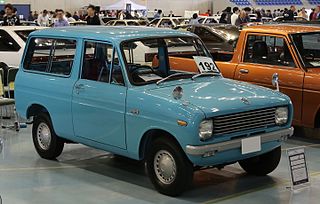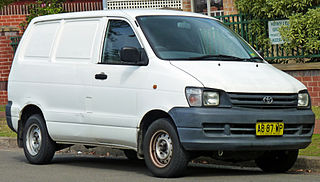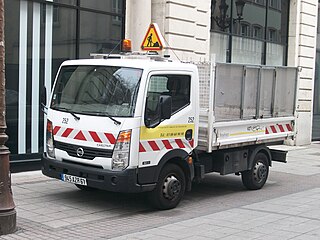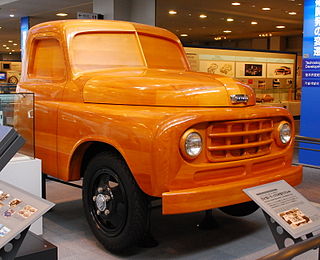First generation (1954)
| Toyota BA/FA/DA (first generation) | |
|---|---|
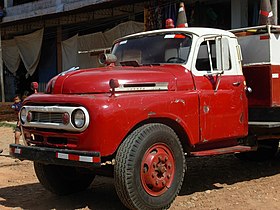 | |
| Overview | |
| Type | Truck |
| Manufacturer | Toyota |
| Also called | Toyota BC/FC/DC |
| Production | 1954–1964 |
| Assembly | Toyota Koromo plant |
| Body and chassis | |
| Class | Class 3 truck |
| Body style | 2-door truck |
| Related | Toyota BB/DB/FB buses |
| Powertrain | |
| Engine | |
| Chronology | |
| Predecessor | Toyota BX/FX |
| Successor | Toyota DA100/FA100 Toyota Massy Dyna (for cab-over models) |
Introduced in February 1954, the original models were 4-or-4.5-tonne (8,800 or 9,900 lb) trucks (BA and FA respectively) on a 4,150 mm (163 in) wheelbase. [1] Visible changes vis-a-vis the earlier BX and FX trucks were mainly limited to a new grille, but the 3878 cc (236.7 cu in) F engine in the FA was upgraded, gaining ten horsepower for a total output of 105 PS (77 kW) at 3000 rpm. The BA's 3386 cc (206.6 cu in) Type B engine still produced 85 PS (63 kW) at 3000 rpm. In March the 2.5-tonne (5,500 lb) BC model was added, followed by the F-engined FC in June. [1] The BC and FC have a 3,000 mm (120 in) wheelbase and were often used as tractor units.

The heavier FA sold very well in a changing Japanese trucking market which was moving to larger loads and greater distances. [2] Accordingly, in September 1954 Toyota lengthened the FA's chassis and upgraded it to carry 5 tonnes, renaming it the FA5. [1] The smaller BA and BC were discontinued in February and July 1956. Also in February 1956, the FA5 was facelifted with a wider grille and equipped with a transmission with synchromesh on second through fourth gear (a first for the segment in Japan) and renamed the FA60. The new name did not reflect a change in payload, which remained at 5 tonnes (11,000 lb). Simultaneously, the lighter FC received similar changes, becoming the FC60 in the process. The FC60 became the FC70 in January 1958, reflecting an increased compression ratio and a power increase to 110 PS (81 kW) for the F engine. Along with a payload upgrade to 3 tonnes (6,600 lb) it was renamed the FC80 in November 1959. This was kept in production until September 1964, when it was replaced by the second generation FC100. The FA60 became the FA70 in January 1958, with the same engine upgrade as for the FC70. [3] The heavier part of the F-engined range was split into two in September 1959, with the FA80 and FA90 being built to handle 5 or 6 tonnes (11,000 or 13,000 lb) respectively; these model codes were again maintained until the first generation was replaced.
In March 1957 the diesel-engined DA60 was introduced. The all new "D" engine was a pre-combustion diesel straight-six displacing 5890 cc (359 cu in) and producing 110 PS (81 kW) at 2600 rpm. [4] The DA60 also prompted Toyota to introduce the new Toyota Diesel Store sales network, which remained until 1988 and was the exclusive distributor of Toyota's diesel-engined vehicles in Japan. This became the DA70 at the beginning of 1958. As with the petrol-engined models, the diesel lineup was split into the 5-tonne DA80 and the 6-tonne DA90 in September 1959. Unlike the petrol-engined models, however, the 6-tonne diesels also received a new, larger and more powerful engine. The 2D displaces 6,494 cc (396 cu in) and produces 130 PS (96 kW). [3] There were also the long-wheelbase DA95/FA95, with 4,400 mm (170 in) between the axles. Some diesel-engined models carry an "H" suffix (such as a DA90-H); this signifies a model with a two-speed rear axle, giving a total of eight forward speeds.
Appearance
In late 1959 the lineup was refreshed and the grille was changed to incorporate two yellow marker lights. In late 1961 (for the 1962 model year) the range was facelifted again, with a single-piece curved windshield replacing the earlier split unit. This was Japan's first heavy truck with such a fitment. [3] At the same time, the grille was stamped directly with widely spaced "TOYOTA" lettering rather than having chromed letters mounted to a red bar as earlier.
Cabover trucks
With the sales of bonneted trucks slowing down in Japan at this time, reflecting ever more congested city streets, Toyota developed a 4-tonne (8,800 lb) cab-over version on a 3,400 mm (130 in) wheelbase. [5] Based on the medium-duty FC80 model, the new DC80C was presented in October 1963, fitted with the D-type diesel engine and a tilting cab. As with the bonneted models, the 5.9-liter D-type six-cylinder engine develops 110 PS (81 kW). Because the engine was mounted between the seats, the cabover model could only take two occupants. [6] The DC80C initially sold very well, but problems with the drivetrain as well as the chassis meant that it soon lost out to its competitors. [5] At the same time as the DC80C, the petrol-engined FC100C with 130 PS (96 kW) was also introduced. The cabovers received a facelift in September 1966. [7] The 4-ton cabover trucks were both replaced by the new Toyota Massy Dyna in September 1969.



